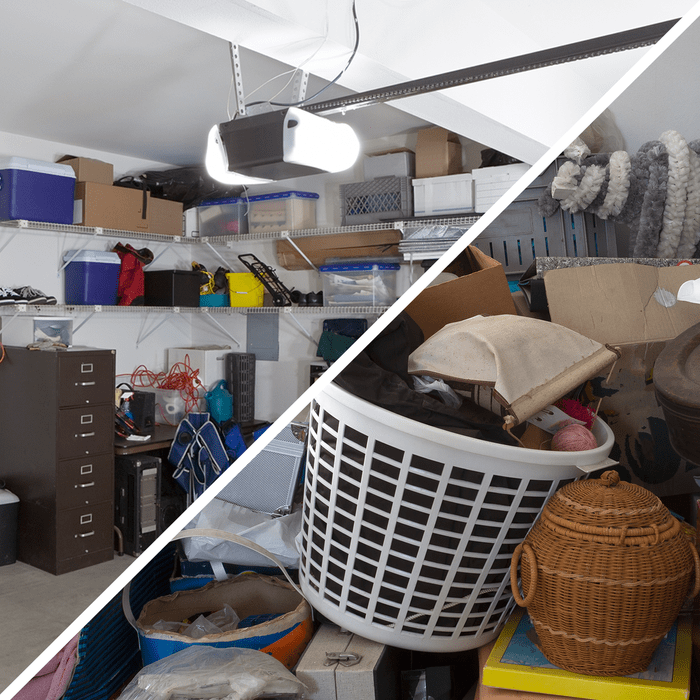Clutter vs. Hoarding: What’s the Difference?

We all struggle with clutter, but hoarding can cause serious safety and hygiene issues for you and your home. Learn how to spot the difference.
Clutter makes it difficult to enjoy our homes to the fullest. Clutter can make it tough to feel motivated to clean or invite people over. But how do you know if clutter is simply a result of some bad habits or if it indicates a deeper issue— like hoarding?
First, it’s important to understand hoarding is a distinct psychological disorder that goes beyond clutter. That’s according to Joseph Kim, an assistant professor at the Huntsman Mental Health Institute with a doctorate in clinical psychology. “Not a lot is known about why people develop hoarding problems,” he says.
Many people develop symptoms before age 20. But for at least a quarter of people, the disorder comes on after age 40 or 50. Unfortunately, limited evidence exists for effective treatment, Kim says, although some studies have shown promise.
On This Page
What Is Clutter?
“Clutter is anything that doesn’t have a home,” says Brenda Scott, a professional home organizer and owner of Tidy My Space. “It’s the stuff that no one knows where it belongs, so it gets dropped anywhere and everywhere.”
This doesn’t always mean you have piles of stuff everywhere, Scott says. It’s more about constantly moving things around, fruitlessly searching for things or lacking storage solutions.
What Is Hoarding?
“Hoarding refers to a behavior where someone has difficulty throwing away or letting go of their possessions, even if they may not have much value,” Kim says. People with hoarding disorder may save boxes, plastic bags and junk mail, Kim says. “This difficulty is thought to be caused by a strong urge to save items and distress around throwing them away,” he says.
Kim says people in any age group can develop hoarding disorder, but how it manifests and the risks involved present unique problems for older adults.
Older adults have “more physical ailments, a greater likelihood of having cognitive difficulties, and a higher risk of social isolation associated with the context of aging,” Kim says. “Each of these factors can cause a greater adverse impact on mental and physical health caused by hoarding behavior.”
Clutter vs. Hoarding
Kim says hoarding differs significantly from clutter. “Many people may be surprised to hear hoarding disorder is at its core a type of anxiety disorder,” Kim says. “This is because anxiety — of throwing away objects — is a fundamental driver of what causes hoarding behavior.”
People with hoarding disorder often lack insight into their behavior. That’s why television show-style interventions offer superficial solutions, Kim says, and don’t address the underlying behavioral patterns.
“When something like this happens without improving insight, or addressing the underlying anxiety [or other psychiatric issues] that promote hoarding behavior, patients are very likely to re-accumulate hoarded objects,” he says.
So while we all deal with clutter from time to time, hoarding is a distinct disorder that will not be solved by just getting rid of the hoard. Kim says it’s similar to taking alcohol from a person with an alcohol use disorder. “We do not expect them to get better just from that, do we?” he says.
Do I Hoard or Am I Just Messy?
According to the American Psychiatric Association, diagnosing hoarding disorder may include asking the following questions:
- Do you have trouble parting with possessions, whether discarding, donating, recycling or selling?
- Is it difficult for you to use the rooms and surfaces of your home due to the clutter?
- Does hoarding, saving, acquisition and clutter affect your daily functioning? To what extent?
- How much do these symptoms interfere with school, work, social or family life?
- How much distress do your symptoms cause you?
Impacts of Clutter on Your Home
A cluttered home is harder to clean, which contributes to higher concentrations of allergens like dust mites. Dust mites don’t stay in the air like pet allergens, but they settle on everything. Reducing clutter is key to removing the places dust mites live, according to the American Lung Association.
Reducing clutter also makes your home safer. Excess clutter creates combustibles that can provide fuel in a house fire, Scott says, and prevent emergency services from reaching you quickly.
Impacts of Hoarding on Your Home
Hoarding disorder creates significant safety and hygiene issues for the home, Kim says, particularly for older adults.
“The majority of older adults with hoarding problems will experience substantial difficulty moving through their home: using their sofa, refrigerator, kitchen sink, bathtub, as well as difficulty preparing food,” he says.
Hoarding can also damage your home’s structure, according to the International Obsessive-Compulsive Disorder Foundation.
- Pest infestations: Rodents may chew through walls or wiring. Pests can migrate to other homes and apartments.
- Stress on building materials: Weight from hoarded items can exceed load limits of the structure.
- Flooding or fire risk: This comes with unmaintained pipes, heating systems and electrical wiring.
How To Start Decluttering When You Feel Overwhelmed
Scott offers these tips for people who feel overwhelmed at the prospect of decluttering:
- Divide up your rooms and projects into manageable chunks. Decluttering doesn’t need to happen all at once.
- Start with things without emotional attachment, like sports equipment in the garage instead of photos and other memorabilia.
- Start with the area that would give you the greatest sense of accomplishment, or that’s causing you the most stress.



